There are several species of spiders in Missouri. Because animals and arachnids don’t listen to state boundaries, not all species cover the whole state. Some are widespread, while others are just in a few counties.
Missouri is home to a few poisonous spiders. These tend to be widespread, but most are easily identifiable.
By learning the species of spiders found around you, you can more easily identify them when it matters. With a bit of background knowledge, it is often easy to pick out the poisonous spiders from harmless ones.
While there are over 30 species of spiders in Missouri, we’re going to focus on the most common ones.

The 12 Spiders Found in Missouri
The 2 Poisonous Spiders in Missouri
1. Brown Recluse

| Species: | Loxosceles reclus |
| Longevity: | 1 – 2 years |
| Good to own as a pet?: | Yes |
| Legal to own?: | Yes |
| Adult size: | 9 mm |
| Diet: | Insects |
The brown recluse is one of the few venomous spiders in Missouri – and by far the most common one. They’re entirely brown, as their name suggests. The easiest way to identify them is by their violin-shaped marking on the top of their carapace.
The legs are usually darker than their body and quite slim. Females are around 9 mm, while males can be a bit smaller. Both sexes are poisonous, though the male is slightly less so due to their smaller size.
They build small, untidy webs under rocks and stones. They are shy spiders and like to hide, so you’ll typically find them in unfrequented areas. Many people get bitten after they put on hardly-worn clothes or shoes.
These spiders are not very good at walking on smooth surfaces. They are often found trapped in bathtubs and sinks.
While they are venomous, the effects usually aren’t as harmful as most people believe. Many people are hardly affected by the venom, leading to little more than a painful bite. Sometimes, ulcers form on the bite, which then bursts and takes a bit to heal.
They usually do not cause death.
2. Black Widow Spiders
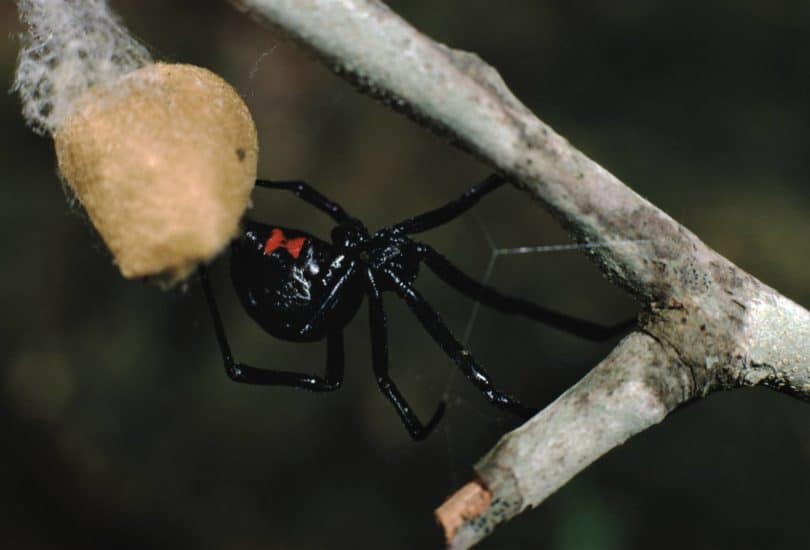
| Species: | Latrodectus mactans |
| Longevity: | 1 – 3 years |
| Good to own as a pet?: | Yes |
| Legal to own?: | Yes |
| Adult size: | 8 – 10 mm |
| Diet: | Insects |
The black widow spider is one of the most well-known venomous spiders in Missouri. There are many different species of a black widow – two of which are in Missouri.
Both species are black. However, only one has the stereotypical red hourglass marking on their belly – the only many have vague red or white spots. Only the female is venomous; the male is a bit of a wander, but not dangerous.
This spider is a bit shy and prefers to flee when disturbed. They only bite when cornered and otherwise unable to escape.
Their bite usually isn’t painful at first. Abdominal cramps, headache, nausea, sweating, and soreness are common symptoms. You may notice swelling around your hands, feet, or eyelids. Usually, symptoms are not localized around the bite site.
Medical attention can relieve some of the discomfort, which can last for several days. Death is uncommon.

The 10 Non-Poisonous Spiders in Missouri
3. Texas Brown Tarantula
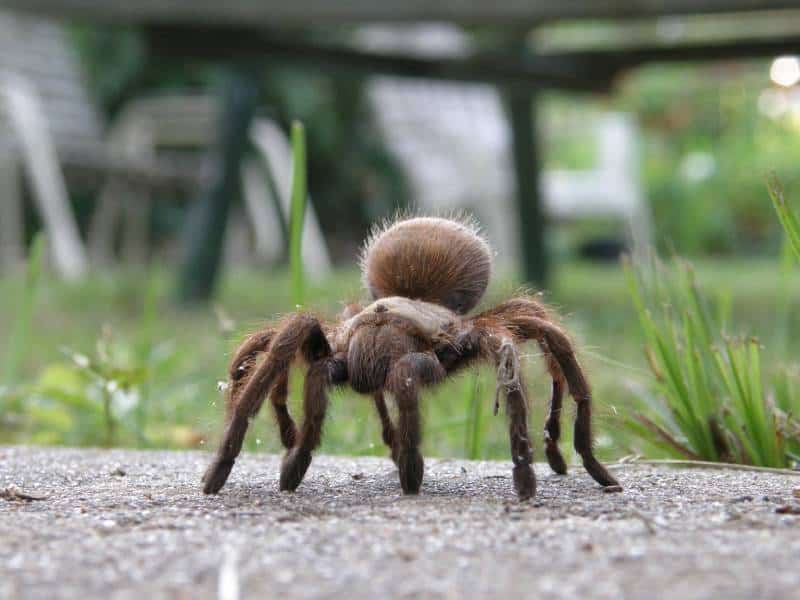
| Species: | Aphonopelma hentzi |
| Longevity: | 30+ years |
| Good to own as a pet?: | Yes |
| Legal to own?: | Yes |
| Adult size: | 50 – 40 mm |
| Diet: | Insects |
This tarantula is an enormous spider in Missouri. It is also known as the “ordinary tarantula,” one of the more usual species.
It features a uniformly chocolate-brown coloration, with some reddish hairs on some individuals. They are pretty large and shaggy in appearance – often leading people to believe they are rather scary. However, these spiders are pretty shy and will attempt to hide in most cases.
They usually spend their time away from people.
They prefer dry, rocky areas, where they can spend their time in burrows hiding. They are active at night when they spend their time hunting insects.
4. Filmy Dome Spider
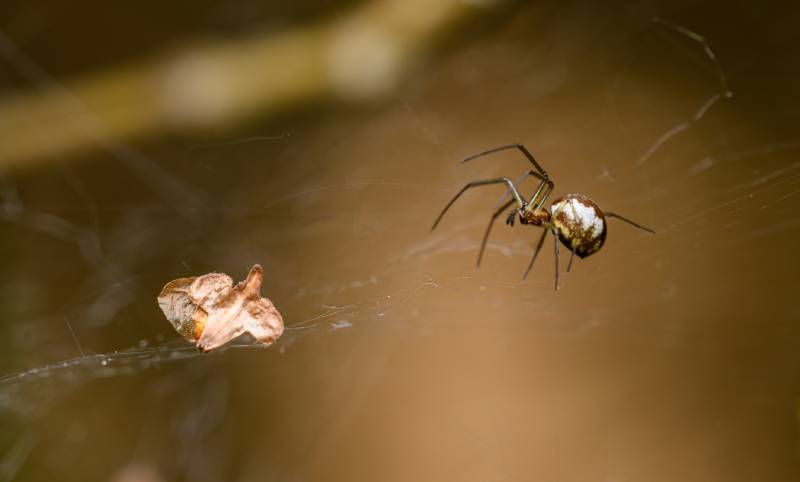
| Species: | Neriene marginata |
| Longevity: | Unknown |
| Good to own as a pet?: | Yes |
| Legal to own?: | Yes |
| Adult size: | 3.5 – 5 mm |
| Diet: | Insects |
This species is one of the most prolific spiders in Missouri – especially in the woodland. They are incredibly tiny, but their unique web makes them relatively easy to find. They build them throughout the year, so they tend to be a reliable part of the landscape.
Usually, they build their webs on rocks, walls, woodpiles, and dense brush. They aren’t usually found in open areas – preferring the safety of dense woods.
They have a yellowish-white abdomen that makes them pretty easy to identify. Their mottled brown markings set them apart from other spiders, as well.
This spider is one of the few that is located state-wide.
5. Grass Spider

| Species: | Agelenidae |
| Longevity: | 1 year |
| Good to own as a pet?: | Yes |
| Legal to own?: | Yes |
| Adult size: | 10 – 22 mm |
| Diet: | Insects |
Grass spiders are prevalent. This category includes many different species, which all vary slightly from each other. However, most people only need to know how to identify them as a family.
They make sheet webs about 3 feet wide with a funnel. These funnels are often found more than the spiders themselves, as they are pretty easy to locate. These webs are usually found in short grasses.
They are usually primarily brown. Different subspecies have different markings. Most have darker bands that run along their body. Many have red zig-zag stripes. Quite a few have cream-colored borders.
6. Six Spotted Fishing Spider
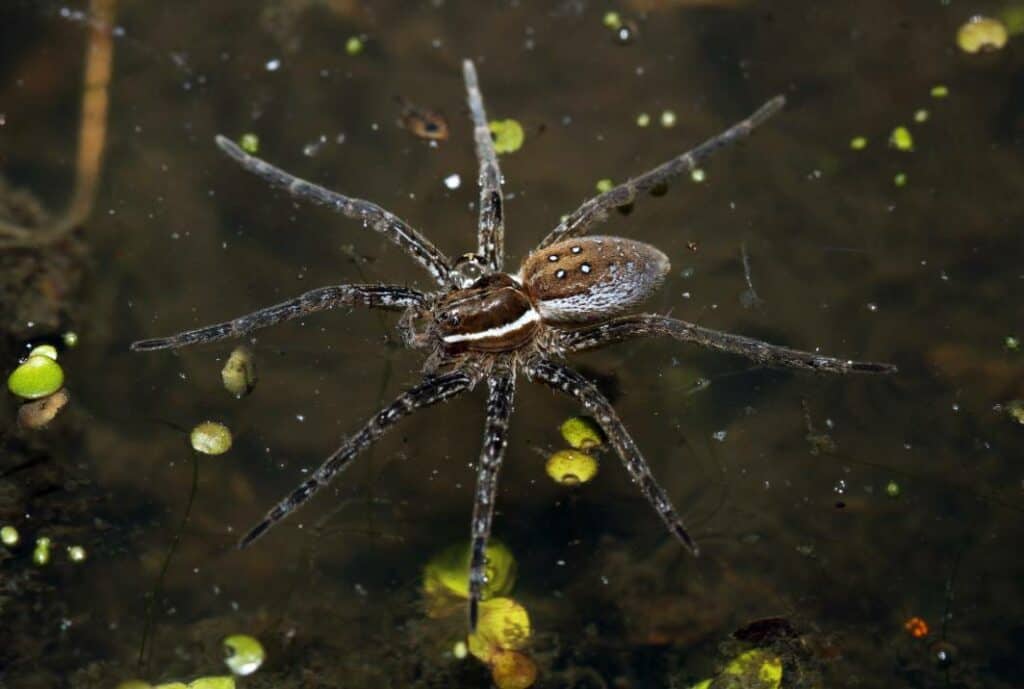
| Species: | Dolomedes triton |
| Longevity: | 1 – 2 years |
| Good to own as a pet?: | Yes |
| Legal to own?: | Yes |
| Adult size: | 9 – 20 mm |
| Diet: | Insects and small fish |
As the name suggests, these spiders live off of aquatic insects and small fish, like tadpoles. They can encase their body in air bubbles to submerge themselves for several minutes if necessary. They can also run on the surface of the water and dive for prey.
They often live near ponds and other damp places where their food sources can be found.
They are primarily black, with white outlines along their body. They may also have white stripes on their arms. They also have three distinct pairs of tiny white spots on their back.
7. Yellow Garden Argiope
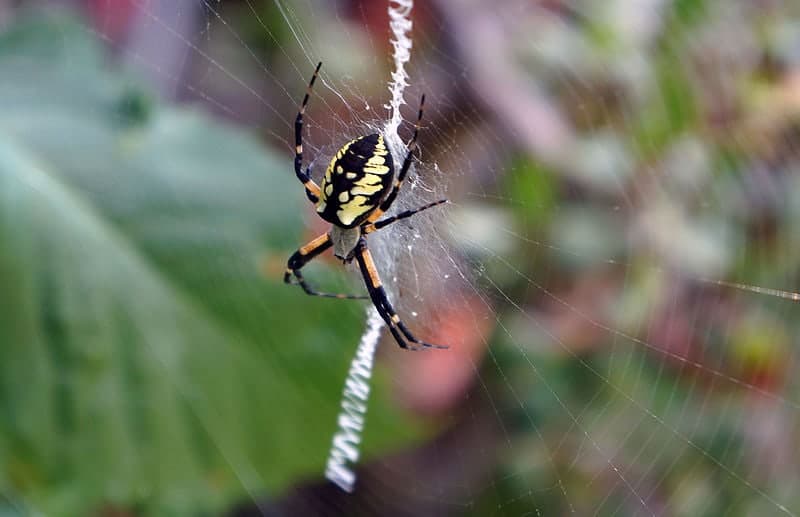
| Species: | Argiope aurantia |
| Longevity: | 1 year |
| Good to own as a pet?: | Yes |
| Legal to own?: | Yes |
| Adult size: | 5 – 28 mm |
| Diet: | Insects |
This Argiope is quite distinctive due to its large size. They usually build their webs near houses and aren’t particularly shy, which is another reason they are commonly seen.
They prefer taller grass, where they can build their webs.
Their abdomen is oval and patterned with yellow and black. Some individuals have markings that are closer to orange than yellow.
They have a black stripe down the top of their abdomen, with four distinctive white dots in the middle. They are pretty unique as far as spiders go, so they are not challenging to identify.
8. Banded Argiope
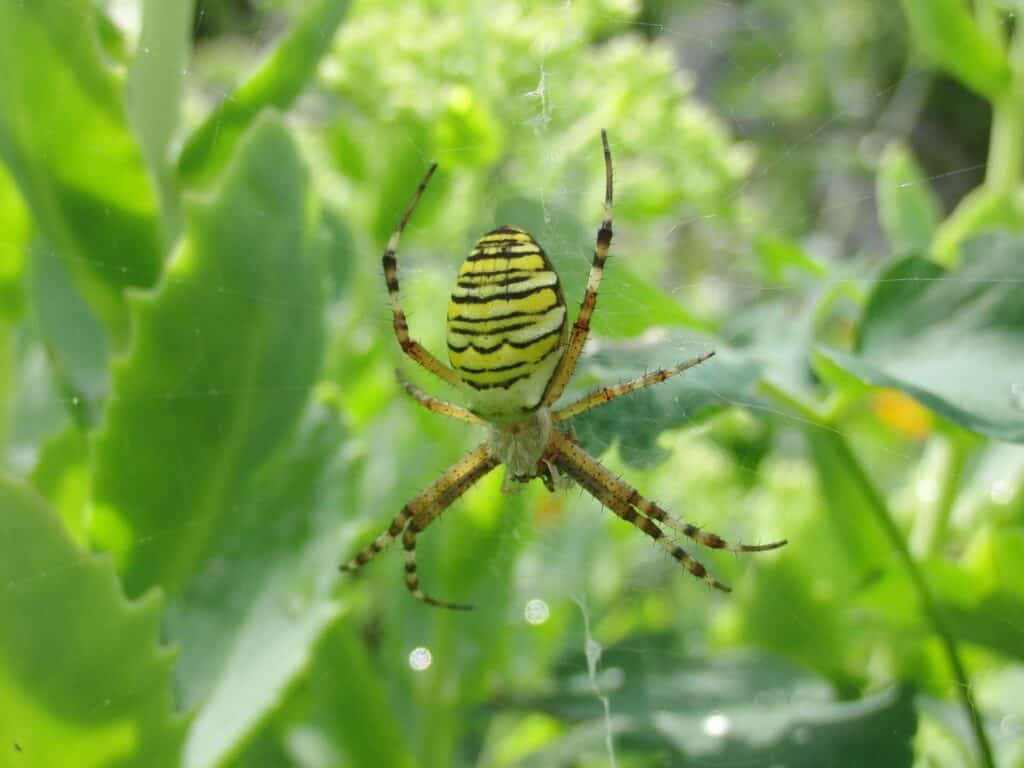
| Species: | Argiope trifasciata |
| Longevity: | 1 year |
| Good to own as a pet?: | Yes |
| Legal to own?: | Yes |
| Adult size: | 4 – 25 mm |
| Diet: | Insects |
This spider looks a lot like the previous one we reviewed. However, they are slightly smaller – though usually not enough to notice to the untrained eye. It has a sharply pointed abdomen, which makes it a bit easier to identify.
Their abdomen has many small silver and yellow lines interspaced with thicker, black lines. The females are substantially larger than males and usually, the ones most noticed.
This species usually builds their web slightly lower than the yellow garden Argiope. They are more tolerant of open areas, including those with plenty of sunlight and sparse brush. These two species are often found together, however.
9. Wolf Spiders
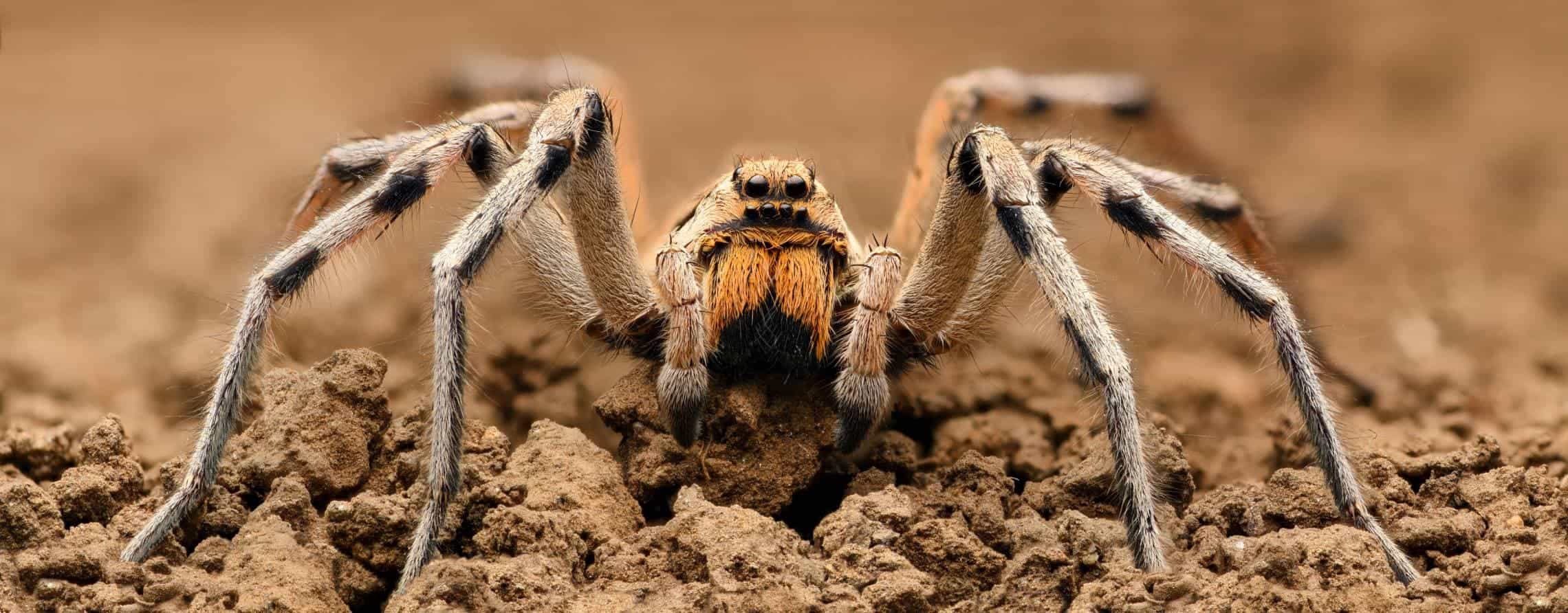
| Species: | Pardosa spp. |
| Longevity: | 1 – 3 years |
| Good to own as a pet?: | Yes |
| Legal to own?: | Yes |
| Adult size: | 6 – 25 mm |
| Diet: | Insects |
Wolf spiders are one of the most common species in Missouri – and worldwide. The males are much smaller than the females, though the exact size ranges from species to species.
These spiders are found in many different habitats, ranging from stream edges to sandy fields. They prefer soft soil, as they make permanent and temporary burrows for safety purposes. They either dig into the soft earth or burrow between rocks and logs.
They eat primarily other ground-dwelling insects and tiny spiders.
10. Arboreal Orb Weaver
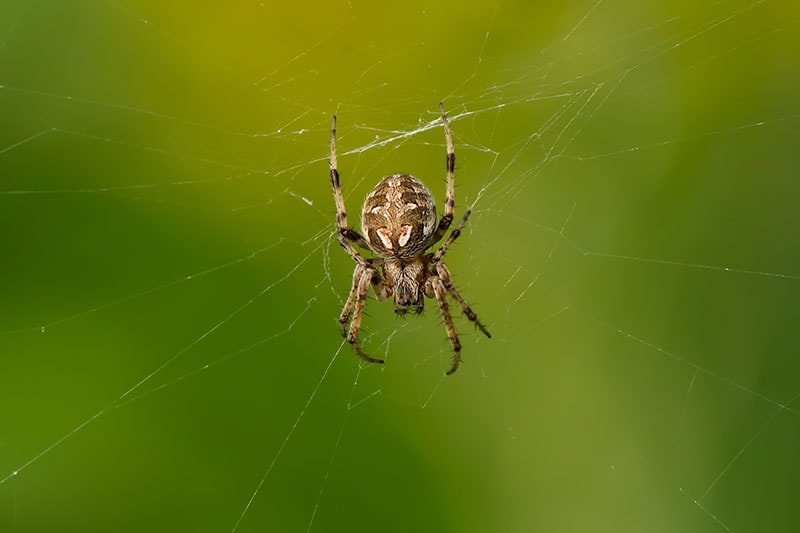
| Species: | Neoscona spp. |
| Longevity: | 1 year |
| Good to own as a pet?: | Yes |
| Legal to own?: | Yes |
| Adult size: | 8 mm |
| Diet: | Insects |
There are several species of orb weaver in Missouri. Many look pretty similar, so they can be hard to tell apart by the untrained eye. Luckily, they’re all harmless – so telling them apart isn’t very important.
These spiders are giant and standard in open fields. They can be found around tall grass, fence posts, and buildings.
The exact coloration and markings depend on the species. Most are around 8 millimeters, though this also depends on the exact species.
Unlike most spiders, orb weavers destroy their web at the end of every night and rebuild it every afternoon. They mostly eat nocturnal moths and similar insects, as their webs are only functional during the night.
11. Goldenrod Crab Spider

| Species: | Misumena vatia |
| Longevity: | 1 – 2 years |
| Good to own as a pet?: | Yes |
| Legal to own?: | Yes |
| Adult size: | 6 – 9 mm |
| Diet: | Insects |
As their name suggests, this species looks a bit like a crab. They are often confused with other crab species – as there are many in Missouri.
This species ranges from yellow to white. They do have the ability to change colors depending on the flowers they’re inhabiting. However, this takes quite a while – the color change is not instant by any means.
They lie in flowers concealed until a bee, or similar insect shows up – which becomes their meal.
The males are particularly unique, with purple legs and a greenish body.
12. Foliage Crab Spider
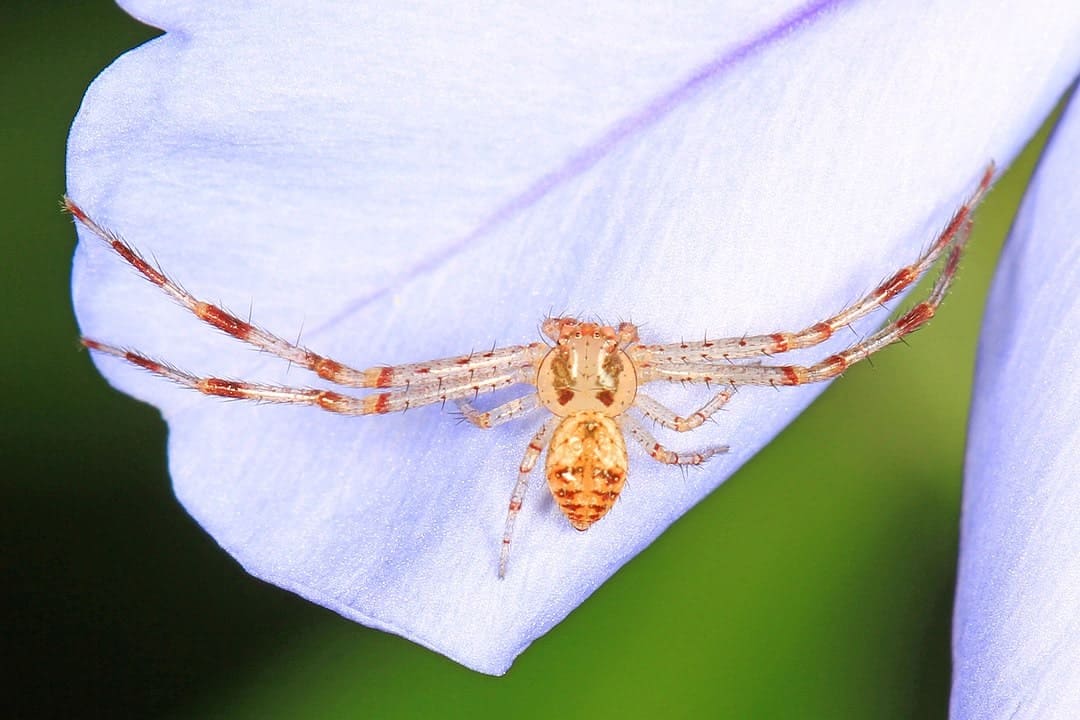
| Species: | Misumenops spp. |
| Longevity: | Unknown |
| Good to own as a pet?: | Yes |
| Legal to own?: | Yes |
| Adult size: | 4 – 6 mm |
| Diet: | Insects |
These crab spiders are smaller than most. They have spiny bodies and aren’t nearly as bulky as other species. Their entire body and legs range from pale green to white. They also have greenish-yellow markings throughout their body.
They hide in flowers like many crab spiders, waiting for pollinators to show up for them to eat. They can be found in the same blossoms as most other crab spiders.

Conclusion
There are many different species of spiders found in Missouri – far too many to cover in this article. However, only two notable species are venomous – the brown recluse and black widow. Both of these species are easy to identify.
There are many more significant (and potentially scary) species, but most are harmless. For instance, there is a tarantula native to Missouri, but it is shy and harmless. Orb weavers tend to be relatively more significant, but they are also docile and rarely bite. Their large size and temperament make them common pets.
You may also be interested in:
Featured Image Credit: Mario Kirschbaum, Shutterstock
